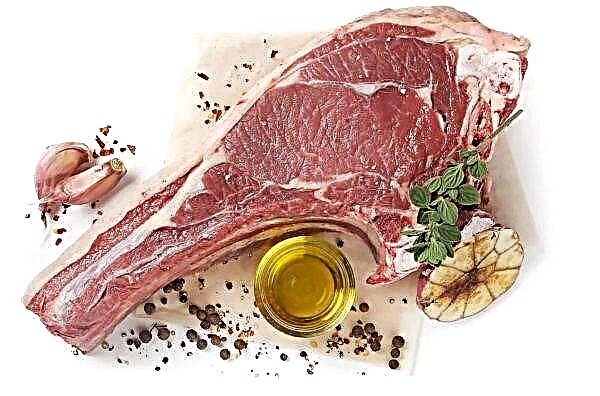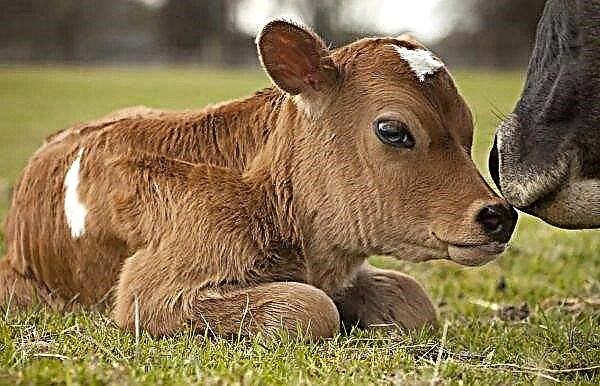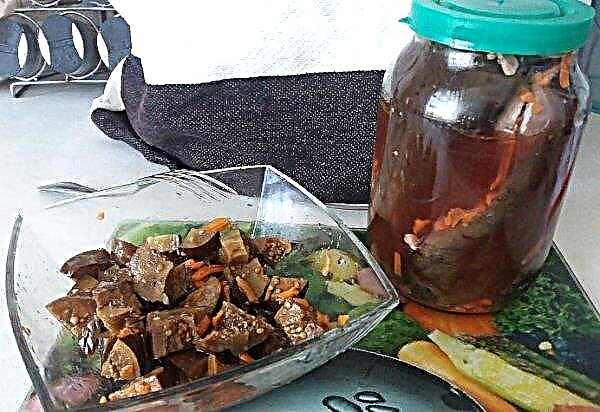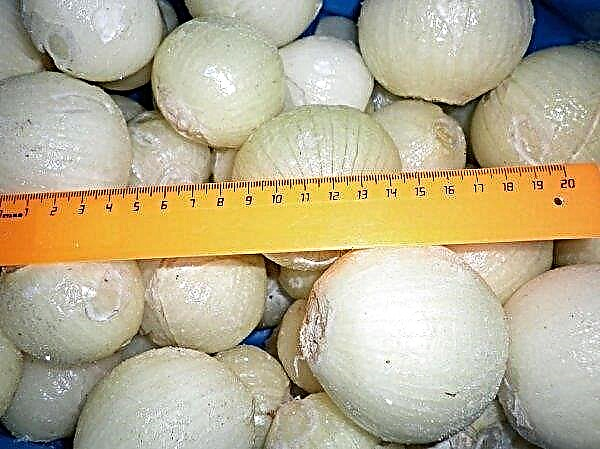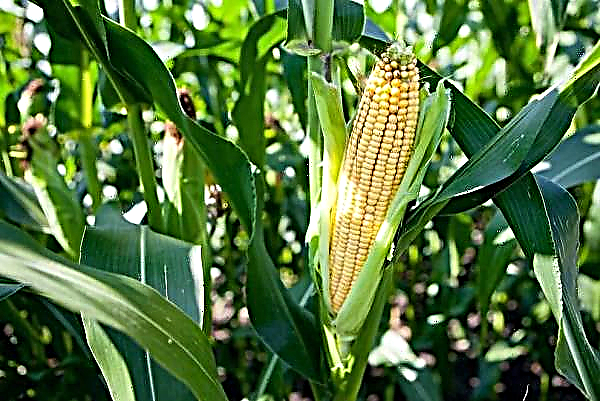Roundworms are a type of roundworm that grows to 0.2–0.4 m in length. Adult individuals "live" in the small intestine and are able to actively move there. Ascaridosis is an ailment caused by the vital activity of worms in the body of an animal or person and causing intoxication of the whole organism. This disease is most common among other helminth ailments in pigs. How to recognize this disease and how to overcome it, we will tell in this article.
Disease characteristics
Roundworms, getting into the animal’s body, in the early stages attach to the walls of the small intestine and parasitize in it. In 45% of cases, worms are found even in the hepatic ducts and in the pancreas. Often they can be found in the stomach.
Since the parasite goes through all stages of development in the body of the "owner", they manage to cause serious harm to the animal during its entire life cycle. And because the worms do not need an intermediate host, the infection of a healthy individual occurs very quickly, and a pig of any age can become a new "host" for the parasite. 70% of sick individuals are usually 3–6 months old.

How does infection occur in pigs
The causative agent of the disease is the nematode Ascaris suum from the Ascacidae family. It is often called pork ascaris. It usually parasitizes in the small intestine, sometimes in the ileum and duodenum. In such a favorable environment, a female helminth produces 100–250 thousand eggs per day, which go out together with feces of a pig. After a couple of weeks, larvae emerge from the eggs, ready to settle in the body of the new “master”.
If the sanitary conditions in the pigsties are not up to standard, the room is damp, poor floors or the corral is located in the sand, then the spread of worms will occur rapidly. In addition, the larvae are often swallowed by earthworms, which can be eaten by a pig. Eggs can also be “stored” in the body of flies, bugs, and other insects, so pigs can easily become infected with worms on pastures, at the place of walking. They can easily absorb contaminated water or food, on which the fly sat.
Important! Ascaris eggs are very resistant to environmental influences. They feel especially good in the sand.
What is the effect of roundworm on pigs
Roundworms, having entered the pig’s body with larvae, begin their cycle with the respiratory system. As they mature, they move into the intestines. Their waste products can cause an allergic reaction in the animal and the destruction of body tissues. At the stage of puberty, roundworms can easily cause blockage of the intestine, bile ducts in the liver and even provoke a rupture of the intestinal wall. Being in the body of newborn piglets, they cause severe allergic reactions, accompanied by nervous disorders in the form of seizures, paralysis.
Staying in the respiratory tract, helminths provoke the development of ascariasis pneumonia and other pathological changes.

The main signs and causes of the disease
Ascaridosis can occur in acute or chronic form. Young worms infected with worms begin to lag behind in growth and development. Digestive upsets are observed. The same thing happens with adults. In the acute variant of the development of the disease, convulsions appear, the animal can gnash its teeth, paresis or paralysis occurs, the temperature rises to 40 ... 41.5 °, the skin becomes covered with a rash. If the parasite is in the respiratory system, then a cough occurs, breathing quickens, vomiting appears, signs of pneumonia. In young animals, most often the disease ends in death.
Important! Symptoms of the acute form may occur within 1–2 weeks. The resulting attack lasts 2-3 minutes and is often accompanied by severe pain.
How to make a diagnosis
You can suspect a problem after detecting the symptoms described above, but you can definitely make a diagnosis only after analyzing the feces of a sick animal.
There are several diagnostic analysis methods:
- Fulleborn Method. The test sample is immersed in saline. If the parasite was in the pig's body, then worm eggs will appear on the surface of the solution. This method is the simplest, but it takes a lot of time, because the eggs do not float quickly.
- Shcherbovich method. The sample is dissolved in mineral salts, centrifuged, and then examined under a microscope. It allows you to fairly accurately determine the presence of a parasite, but it takes even more time than the first method.
- Berman-Orlov. Fresh excrement is dissolved in water and precipitated under a microscope. The technique is accurate, but requires special equipment.
- Kalantaryan. Excrement sample combined with NaNO3. If there are eggs, then they will pop up, but it will take some time.
- Darling. The sample is passed through a centrifuge, on which the parasite's eggs are screened.
Did you know? Karl Linnaeus gave the modern name to the ascaris parasite in 1758, although the concept of ascaris was introduced by Hippocrates.
Treatment of ascariasis in pigs
In the fight against the disease, anthelmintic drugs and their salts are effective. The most common drug is piperazine (an organic substance from amines that causes paralysis of worms). It is given to a sick individual twice a day, and a single dose for piglets weighing up to half a centner is 0.3 g / 1 kg of body weight, and for adults - 15 g / 1 kg. Usually, this product treats all livestock at once (in groups of 30 animals), adding the necessary dose of the medicine to the feed.
There are other means:
- Hygromycin B (highly effective antibiotic that inhibits metabolic processes in the tissues of worms). It is added to the feed at the rate of 30 g / 1 ton of feed every day for 35 days. You can give piglets older than two months of age.
- Santonin (getting into the digestive tract, decomposes into poisonous components that kill or paralyze roundworm). It is used in a dosage of 0.05 g / 1 kg of weight, together with calomel (a mineral with antimicrobial action), which requires 0.03 g / 1 kg of weight.
Important! Anthelmintic action has fodder lupine and pumpkin. With prolonged use, parasites can be eliminated from the body.
Disease prevention
In order not to conduct an active struggle with roundworms, trying to save the livestock, it is necessary to carry out preventive measures:
- Deworming of livestock for preventive purposes, especially sows a month before farrowing.
- Deworming after the transfer of the herd from livestock to stall in the winter.
- Deworming of young on schedule.
- Quarantine for new arrivals.
- Disinvasion of “maternity” rooms and feedlots.
- The floor in the pigsty should be made hard, and the sows with young animals should be grazed on grassy pastures.
- Timely cleaning of the pigsty and its disinfection.
- Change pastures every 10 days.
- Pasture disinvasion twice a year.
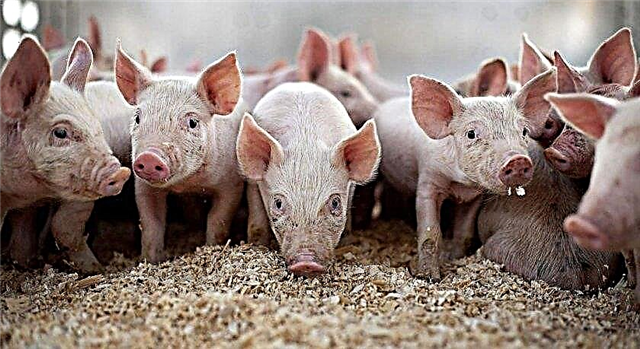
Danger to humans
Roundworms are able to live not only in the body of the animal, but also in humans. In the process of life, worms make their way into the fibers of meat, and if you do not thoroughly heat the meat (at least + 70 ° C) of a pig infected with ascarids, they can easily enter the human body. There, when migrating, the larvae begin to cause an allergic reaction in the form of itching of the nose, cough, rash. If such a person passes a blood test, then he will have an increased number of eosinophils (a type of white blood cell).
Once in the intestines, the parasite will cause abdominal pain, nausea, and excessive salivation. The appetite will disappear, and itching will appear in the anus. Symptoms of general intoxication of the body will also be observed. If there are a lot of worms, then they can cause intestinal obstruction and perforated peritonitis. If it gets into the bile ducts, an abscess of the liver, obstructive jaundice may occur, and if the parasite crawls into the respiratory tract - asphyxiation.
Did you know? In the world 0.8–1.2 billion people suffer from ascariasis.
As you can see, the parasite is capable of causing a lot of harm to the livestock of pigs, therefore it is better to try by all means to prevent the development of the disease, and if it arose, then prevent mass infection. Roundworms are also dangerous for humans, therefore, when caring for sick animals, you must follow the rules of hygiene, and eat meat only after a good heat treatment.







